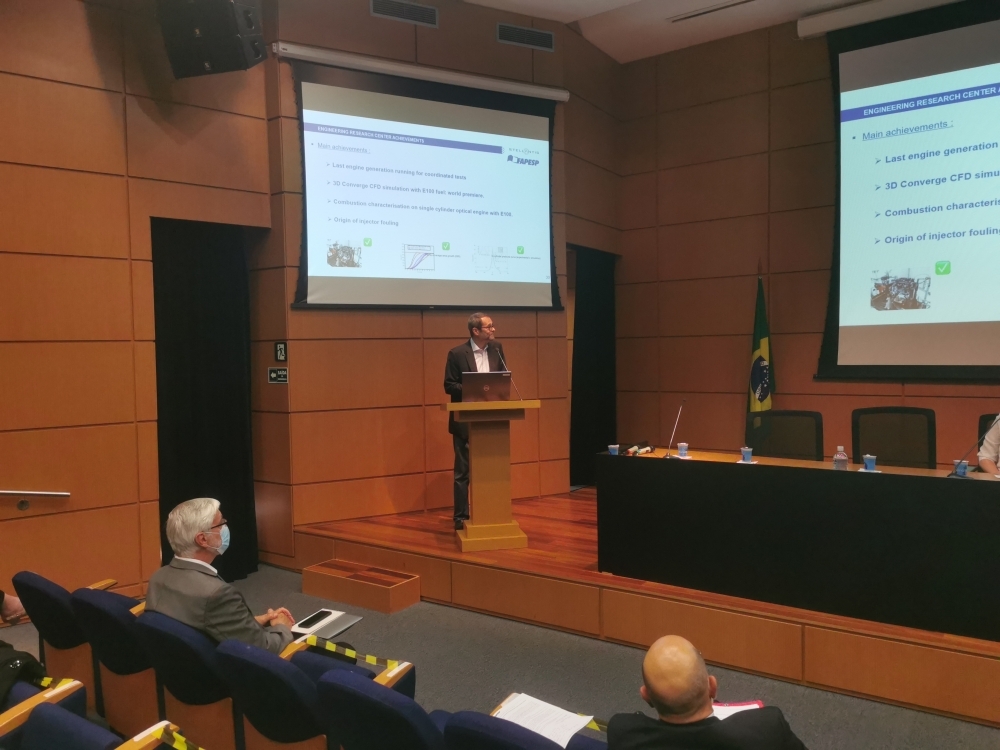


The automotive giant resulting from the PSA-Fiat Chrysler merger is partnering with FAPESP in this ERC, which is integrated with Stellantis’s global network of science labs (photo: Daniel Antônio)
Published on 01/10/2022
By Elton Alisson | FAPESP Innovative R&D – Although the number of electric vehicles (EVs) is rising in Brazil, in line with the world trend, ethanol will continue to be a cheap and sustainable option in renewable fuels, and Stellantis has therefore reaffirmed its commitment to invest in research and development (R&D) on biofuel engines.
The statement was made by Emmanuel Hédouin, research, innovation and advanced engineering manager for South America with Stellantis, the fourth-ranking global automotive manufacturer that resulted from the 2021 merger of PSA with Fiat Chrysler.
“Brazil will probably be the country with the most applications, technical possibilities and powertrain solutions because ethanol is here to stay. That’s a good enough reason to continue doing R&D on ethanol,” Hédouin said during the France-Brazil Research Workshop on Scientific Cooperation in São Paulo State, held on December 10, 2021, in FAPESP’s auditorium.
The Professor Urbano Ernesto Stumpf Engineering Research Center, launched in 2014 by FAPESP in partnership with PSA, has been strategic to orient Stellantis’s R&D in the area, according to Hédouin. “It serves as a benchmark and guide for decisions on ethanol in Brazil,” he said.
Researchers at the University of São Paulo (USP), the University of Campinas (UNICAMP), the Aeronautics Institute of Technology (ITA) and the Mauá Institute of Technology (IMT) work with those of Stellantis at the center.
The center conducts research to extend knowledge of ethanol combustion and develops competencies to act as a local hub in digital and physical tools for the study of biofuels, including 3D simulations and use of a transparent engine to observe combustion. “Another field of expertise at the center is engine bench testing of the guidance provided by laboratories, which is fundamental,” Hédouin said.
The center is connected to the group’s StelLab global network of scientific laboratories, which works with universities and other research institutions.
The center’s researchers collaborate closely with one of the network’s 17 OpenLabs located in France and specialized in research on fuels and powertrain technology. “The network of labs is fairly centralized in France, but branches have extended into several other regions, including China, Africa and the Americas,” Hédouin said.
The center’s main achievements in the seven years since it was set up include coordinated testing on the latest generation of engines developed by the group, and the creation of a method for 3D simulation of computational fluid dynamics (CFD) in ethanol.
Its researchers have also characterized ethanol combustion in a single-cylinder optical engine and identified several key factors that can cause injector clogging. “The results have been most interesting,” Hédouin said.
Other positive points highlighted by the executive were the establishment of partnerships with top-tier universities in the state of São Paulo, strategic alignment with and support from the company, and adaptation of goals at the start of each project phase. “Everything has changed in the automotive world in these seven years, especially in powertrain technology, so FAPESP’s support has been most important to facilitate the transition between the first and second phase of the project in scoping terms,” Hédouin said.
“We had an opportunity to adapt the center’s configuration and change its coordination so as to have more of a focus on applications, and also to leave aside some matters that had already been handled by the group’s R&D department.”
According to him, improvements are needed in aligning the pace of research at universities and the company. “The universities haven’t always been sufficiently agile from our standpoint, but on the other hand, they’re strongly committed to matching our pace in the industry. It’s been a very productive experience,” he concluded.
Shared responsibilities
The center was the first to be established under the aegis of the FAPESP Engineering Research Center/Applied Research Center Program, which provides support for the creation of research centers in partnership with companies at universities or research institutions.
FAPESP has set up Engineering Research Centers in partnership with such companies as Shell, Koppert, Equinor, GlaxoSmithKlein, Natura, EMBRAPA and IBM.
One of the conditions for its support is that the partner company must participate in all dimensions of the center, according to Roberto Marcondes Cesar, one of the coordinators of the program at FAPESP. “The partner company helps us choose the research focus, contributes to funding for the center, and participates in selecting the researchers. After that, it oversees the center’s activities with us, taking part in governance as well as research,” he said.
FAPESP has so far allocated BRL 237 million to funding for all its Engineering Research Centers. When added to the investments made by companies, universities and research institutions, the total exceeds BRL 1 billion, Cesar estimated.
Source: https://agencia.fapesp.br/37689